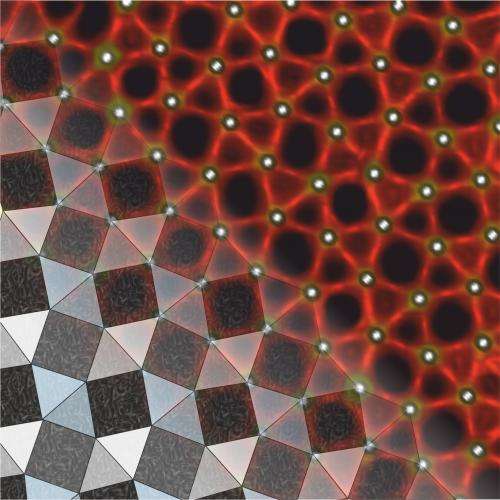The 2-D tessellation pattern known as the "semiregular snub square tiling" stands out clearly in this image, which combines scanning tunneling microscopy with computer graphics. The pattern, observed in a surface architecture just one molecule thick, was formed by self-assembly of linear organic linkers, imaged as rods, and lanthanide cerium centers, visualized as bright protrusions. The area shown measures less than 25 nanometers across. Credit: Barth Lab, copyright TUM
Tessellation patterns that have fascinated mathematicians since Johannes Kepler worked out their systematics 400 years ago – and that more recently have caught the eye of both artists and crystallographers – can now be seen in the laboratory. They first took shape on a surface more perfectly two-dimensional than any sheet of writing paper, a single layer of atoms and molecules atop an atomically smooth substrate. Physicists coaxed these so-called Kepler tilings "onto the page" through guided self-assembly of nanostructures.
The experiments were carried out by postdoctoral researcher David Ecija, PhD candidate Jose Ignacio Urgel and colleagues in the Physics Department of Technische Universitaet Muenchen (TUM), in collaboration with scientists in Karlsruhe and Zurich. They reported their findings in the Proceedings of the National Academy of Sciences.
Results open a new line of research
Organic molecules equipped with functional groups to express distinct linkages to metal atoms were deposited onto a smooth silver substrate under vacuum conditions. Subsequently the organic layer on this platform was exposed to an atomic flux of the lanthanide cerium. At a certain ratio of cerium atoms to molecules, self-assembly produced a symmetrical complex 2-D pattern described originally by Kepler and known today as the snub square tiling. Clearly identifiable through scanning tunneling microscopy was a recurring, five-vertex connecting element less than one nanometer across, a cerium-ligand coordination unit.
That the snub square tiling pattern had never been fabricated and seen at the molecular level by exploiting self-assembly protocols was interesting in itself. Beyond that, the physicists explain, every new surface architecture could potentially open the way to novel physics and chemistry, and until now five-vertex structures have proven elusive. In particular, the fact that the lanthanide element cerium played such a key role marks this as the beginning of a new line of research.
This is the first time the TUM researchers – members of Prof. Johannes Barth's Institute for Molecular Nanoscience and Chemical Physics of Interfaces – have coordinated molecules with a lanthanide, and the first time anyone has done this in 2-D. "And lanthanides are special," David Ecija explains. "They have very intriguing optical, magnetic, and chemical properties that could be interesting for nanoscience, and possibly also for nanotechnology. Now we have a new playground for research with the lanthanides, and beyond."
More information: Five-vertex Archimedean surface tessellation by lanthanide-directed molecular self-assembly. David Ecija, Jose I. Urgel, Anthoula C. Papageorgiou, Sushobhan Joshi, Willi Auwaerter, Ari P. Seitsonen, Svetlana Klyatskaya, Mario Ruben, Sybille Fischer, Saranyan Vijayaraghavan, Joachim Reichert, and Johannes V. Barth. PNAS 2013 Vol. 110 No. 17, pp. 6678-6681. DOI: 10.1073/pnas.1222713110
Journal information: Proceedings of the National Academy of Sciences
Provided by Technical University Munich
























